HA Block 3 Quiz Questions
1/157
Earn XP
Description and Tags
Healthy limbs
Name | Mastery | Learn | Test | Matching | Spaced |
|---|
No study sessions yet.
158 Terms
Antebrachium
The radius and ulna are located in the topographic area know as the?
Radius
The topographic region defined as the Manus consists of multiple bones. Which of the following bones is (are) NOT associated with the Manus?
Median nerve
Unlike the dog, the cat has a supracondylar foramen located at the distomedial aspect of the humerus. Which of the following structures pass through this foramen?
Base
What structure, located on the middle phalanx of digit II, immediately articulates (joins/is in contact with) with the proximal phalanx of that same digit?
Latissiumus dorsi m.
Jaxon the dog wants to bury his bone in the back yard. Which of the following muscles draws the limb caudally and as a result would aid in digging?
Descending pectoral, Transverse pectoral
Which of the following muscles are described as being parts of the superficial pectoral muscle?
Cleidomastoideus, Cleidocervicalis
The brachiocephalicus muscle can be divided into two principle parts; cleidocephalicus and cleidobrachialis. The cleidocephalicus can be further subdivided into the __________________ and ___________________.
false
T/F: A decrease in the angle of a joint upon the contraction of a muscle will result in an extension of that joint.
Flexion/Extension
Contraction of the long head of the tricpes brachii muscle can result in a(n) _____________ of the shoulder joint and/or a(n) _____________ of the elbow joint. (Pick the word pair that makes this statement true)
Infraspinatus
The subtendinous synovial bursa is associated with the tendon of which of the following muscles?
Extend elbow joint
In general, what is the action of the caudal muscles of the arm (brachium)?
Flex carpus and digit
In general, what is the action of the caudomedial muscles of the forearm?
C5
Which of the following cervical spinal nerves does NOT contribute to the formation of the Brachial Plexus?
C8
C7
C6
C5
Radial n.
The extensors of the carpus and digit are innervated by which nerve?
Musculocutaneous
The flexors of the elbow joint are innervated by which nerve?
Teres minor, Teres major, Deltoideus
Which of the following muscle(s) are innervated by the Axillary nerve?
false
T/F: Veins always carry de-oxygenated blood to the heart.
Radial a.
Which artery is not considered to be part of the principal blood supply to the thoracic limb?
Cranial circumflex humeral a.
Which artery is described as being the last branch of the Axillary a.?
Cephalic v.
Which vessel is typically used for venipuncture in the canine's thoracic limb?
Thoracodorsal, Caudal circumflex humoral
The subscapular artery is a branch from the Axillary artery. The subscapular artery will then give rise to which vessels?
Common interosseous
Which artery is described as being the last branch of the brachial a.?
Superficial cervical ln.
Which lymph node is described as being responsible for draining the caudal part of the head, lateral surface of the neck, and the thoracic limb?
Articular cartilage, Synovial fluid, Joint cavity, Joint capsule
Which of the following are components of a synovial joint?
true
True or false:
(Collateral) Ligaments are described as being thickenings in the outer fibrous layer of the joint capsule.
Infraspinatus, Supraspinatus
Luxation of the shoulder is rare because of specific muscle tendons associated with the joint. Which of the following muscles stabilize the joint laterally?
scapula
The tuber spinae is a process on the:
metacarpus
Which topographic region is located between the knee and ankle?
elbow
The flexor surface of which joint is located on the cranial aspect of the limb?
metacarpal IV
Which bone is the lateral splint bone?
thoracodorsal
Which nerve provides motor innervation to the latissimus dorsi?
proximal row, lateral side
Where is the accessory carpal bone located in the carpus?
metacarpophalangeal
What is the anatomic term for the fetlock joint?
proximal phalanx
The long pastern bone is also known as the:
metacarpophalangeal
The proximal sesamoid bones are located at the level of which joint?
medial epicondyle
As a functional group of muscles, the flexors of the carpus and digit originate from which prominence of the humerus?
axillary
Which nerve innervates the muscle group that flexes the shoulder?
lacertus fibrosus
What is the name of the central tendon of the biceps brachii that can be seen leaving the distal end of the muscle and extending into the antebrachium?
radial
The functional group of muscles located on the craniolateral surface of the antebrachium receives its primary motor innervation from which nerve?
brachialis
Which muscle has a primary action of flexing the elbow?
extend the elbow
What is the primary action of the medial head of the triceps brachii?
Midcarpal
Which joint is located between the two rows of carpal bones?
Common interosseous
Which artery is the last branch of the brachial artery?
Medial palmar
What is the name of the continuation of the median artery after it emerges from the carpal canal?
Frog
What is the name of the wedge-shaped structure visible on the, "bottom," of the foot?
Corium of the bar
Which of the following is an example of laminar corium?
Antebrachiocarpal
At which joint level does the greatest amount of motion occur in the carpus?
Metacarpophalangeal
What is the anatomic term for the fetlock/ankle joint?
Medial palmar
Which artery is the principal blood supply to the digit?
Deep palmar arch
Which vascular structure gives rise to the palmar metacarpal arteries?
Median
The medial and lateral palmar nerves originate from which nerve?
Radial
Which nerve gives rise to the lateral cutaneous antebrachial nerve?
Hoof cartilage
Sidebone refers to an ossification of which structure?
Flexor surface of P III
What is the specific insertion for the DDF tendon?
Intersesamoidean ligament
What is a synonymous term for the palmar ligament?
Distal check ligament
The accessory ligament of the deep digital flexor is also known as:
The lateral malleolus
The cranial-drawer test is performed to assess the integrity of the cranial cruciate ligament in dogs and cats. Which one of the following is NOT one of the 4 anatomical landmarks grasped when performing the cranial drawer test?
Barden’s test
Which of the following tests is used to detect coxofemoral instability/laxity?
Cranio-dorsal ilium, greater trochanter, tuber ischia
Which of the following are the palpable anatomic landmarks used to help determine whether the coxofemoral joint is luxated or not.
Foot
You are presented with a 3-year-old bull that has been lame for 10 days in the left hind leg. The owner has treated him with oxytetracycline (antibiotic) and Flunixin Meglumine (NSAID) one week ago. He (or she) noticed that there was some improvement following the medication, but the lameness recurred 1 day after discontinuing medical therapy. What is the most likely localization for his lameness?
Gather additional History; Observe the animal Ambulate; Examine the Hoof; Palpate and examine the remainder of the leg; Radiograph based on the lesion localization
Based on the bull in the previous question, which of the following abbreviated examinations, would approach the workup in the most logical fashion?
Dropped fetlock of the effected limb
Which of the following would NOT be a good indicator of lameness in a limb?
superficial digital flexor tendon; deep digital flexor tendon; suspensory ligament
The palmar/plantar soft tissue structures from the palmar/plantar to dorsal direction are –
False
The carpus is composed of 1 high-motion (radial carpal) and 2 low-motion (middle carpal, carpo-metacarpal joint) joints
Consistency and thoroughness during exam is more important than the sequence of palpation
Which of the following is most appropriate regarding musculoskeletal palpation and the sequence of the exam –
True
Hoof tester evaluation looks for sensitivity in the sole and sub-solar tissues
Right front
A 6-year-old QH has a consistent head bob when the left forelimb hits the ground i.e. head comes down when the left forelimb hits the ground (when trotted on a straight line). Which limb is the horse lame on?
False
The AAEP lameness grading scale is applicable when the horse is evaluated at the canter
Collagen I
Which of the following is the most abundant collagen in normal tendon and ligament?
True
Tendon cells (tenocytes) alone are responsible for extracellular matrix turnover in homeostasis and healing.
Inflammatory/Proliferative/Remodeling
This stage of tendon/ligament healing encompasses the longest duration, and can extend beyond 8-10 months from the onset of injury
False
During the early stages of tendon healing, collagen I/III ratio is increased.
d. All of the above
General guidelines for managing tendon/ligament injuries include
a. Rest from exercise and systemic use of NSAIDs during acute stages of tendinitis.
b. Controlled exercise once the acute stage of tendinitis has passed.
c. Intra-lesional injection of biologics to improve the quality of repair tissue.
d. All of the above
Rectus femoris m.
Ruby is an excellent swimmer. She loves to jump in the water and while doing so, she extends her hip to a full hip extension. From the muscles listed below, which one is not engaged in her hip extension motion?
Pectineus m.
Lovey has developed a tumor next to her obturator nerve. Since her nerve is being impinged by the tumor, she lost her ability to adduct her limb. Which muscle from the list below is responsible for limb adduction?
True
The difference between the acetabular fossa and the acetabular notch is that the "fossa" is the site of attachment for the ligament of the head of the femur while the "notch" it the missing brim of bone on the most ventral aspect of the acetabular bone.
Medial aspect of the lateral condyle
Lucky was playing in the backyard and all of a sudden he yelp and start limping. His physical exam reviewed a torn cranial cruciate ligament. Where is the specific site of insertion of the cranial cruciate ligament in relationship with the femur?
Femoral n.
Lucky is a 2-year-old male/castrated Bernese Mountain dog that presented to you after being hit by a car last night. Lucky can walk, but is very painful and refuses to do so.
Your orthopedic exam findings include:
No fractured bones in either pelvic limb;
Major source of pain in the lumbosacral spine;
Not able to bear weight on his left hindlimb;
The quadriceps femoris muscle doesn’t contract upon stimulation; and
The biceps femoris, middle gluteal, fibularis (peroneus) longus and gastrocnemius muscles contract upon stimulation.
You suspect that Lucky has a neurological lesion. Which of the following nerves is likely involved?
Common peroneal n.
Betsy is an 11-year-old female/spayed Yorkshire Terrier that came to see you because she is no longer using her right hindlimb, not even toe touching. Upon your physical exam, you locate a mass on the lateral aspect of her right stifle. You also palpate a few muscles that are severely atrophied as they have not been stimulated for a while.
Remembering your happy days of anatomy, you are able to list the muscles involved in your physical exam form: cranial tibial, long digital extensor, fibularis (peroneus) longus and lateral digital extensor muscles.
You are pretty sure that the mass is causing nerve damage. Which of the following nerves is likely involved?
Aorta, external iliac a., femoral a., popliteal a., cranial tibial a., dorsopedal a., smaller arterial branches, capillaries, dorsal digital v., lateral saphenous v.
Cocoa is here to see you for a heart-worm test and you need to collect a venous blood sample. Incidentally, today in your clinic you are mentoring a very inquisitive high-schooler who dreams to become a veterinarian.
You choose to perform a venipuncture in Cocoa’s lateral saphenous vein and the high-scholar is impressed with your skills. He asks how that blood got there and you start listing the vessels involved in transporting Cocoa’s blood from his heart to his lateral saphenous.
Which of the following list is correct, in terms of both the vessels involved and the order in which blood travels?
Lateral saphenous v. for the dog, and medial saphenous v. for the cat.
Hazel is here today for a routine visit and she has a new friend in her house hold. Hazel is a cocker spaniel and Basil is a domestic shorthair cat. You are collecting a blood sample from both pets so you can do a heart-worm test on Hazel, the dog and a FIV/FeLV test on Basil, the cat. Considering you must use the pelvic limb only, which site would be the most preferred for each patient?
Medial circumflex femoral a.
The deep femoral artery, a branch from external iliac artery, is a very short vessel that will quickly becomes a new named vessel once the pudendoepigastric trunk branching occurs. What is the name of this vessel that started as deep femoral a.?
Distal caudal femoral a.
What vessel is the main source of blood supply to the caudal muscles of the crus, (tip: these muscles are responsible for tarsal extension and digital flexion)?
Biceps femoris m.
You are doing a physical exam in a very loud room. You remember that you can feel the pulse in the femoral triangle and this will help you determining the heart rate for your physical exam. When looking for the femoral triangle, all of these muscles will help except for:
Cranial tibial a.
You can feel the pulse in all of these arteries, except for:
K+
What ion is most responsible for maintenance of the resting membrane potential?
Na+
Which ion is most responsible for the rapid depolarization phase of the action potential?
hyperkalemia and hypocalcemia
Which of the following conditions produces the greatest increase in membrane excitability (easier to elicit an action potential)?
hyperkalemia and hypocalcemia
hypokalemia and hypocalcemia
hypokalemia and hypercalcemia
. hyperkalemia and hypercalcemia
Frequency modulated (high frequency of action potentials will result in a strong muscular contraction)
Control of muscles by nerve action potentials is ... frequency or amplitude modulated?
All of the above statements are true
Pick the true statement regarding membrane potential:
All cells have a membrane potential
Excitable cells have a higher membrane potential compared to non-excitable cells
In a resting state, the interior of the cell has a more negative potential than the exterior of the cell
All of the above statements are true
It is pumping Na+ and K+ against their concentration gradients
The Na+/K+ exchange helps to maintain the membrane potential. This pump is an active pump and requires energy because.
resting membrane potential
What is A?
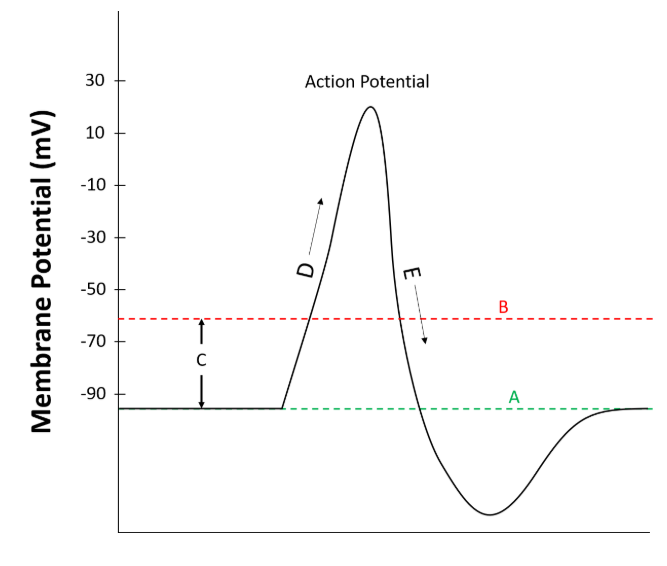
threshold for action potential
B?
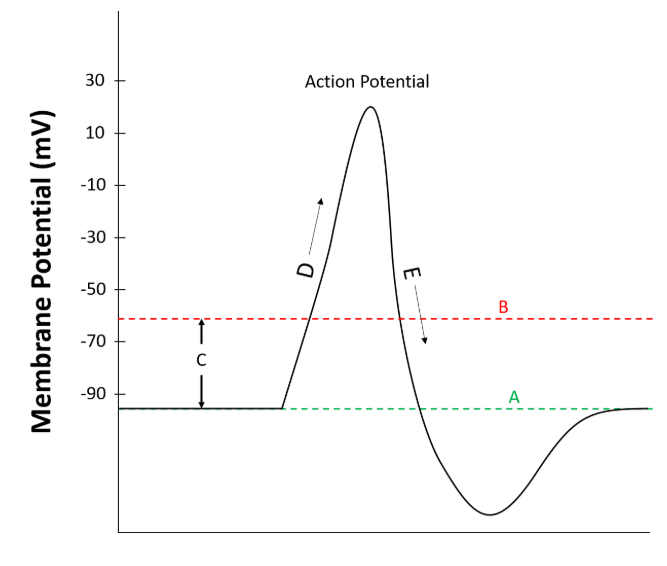
excitability
C?
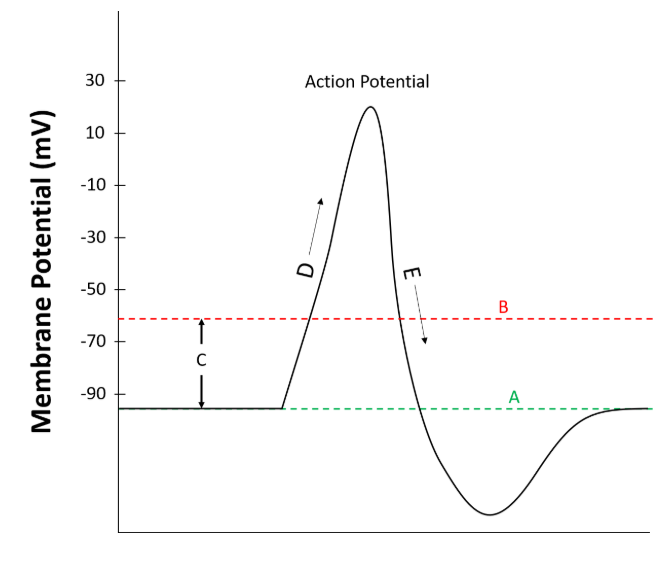
membrane is becoming depolarized
D?
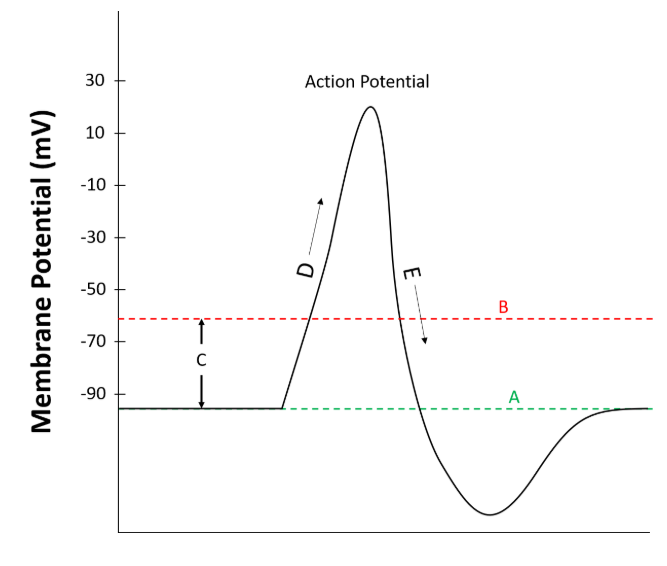
membrane is becoming repolarized
E?
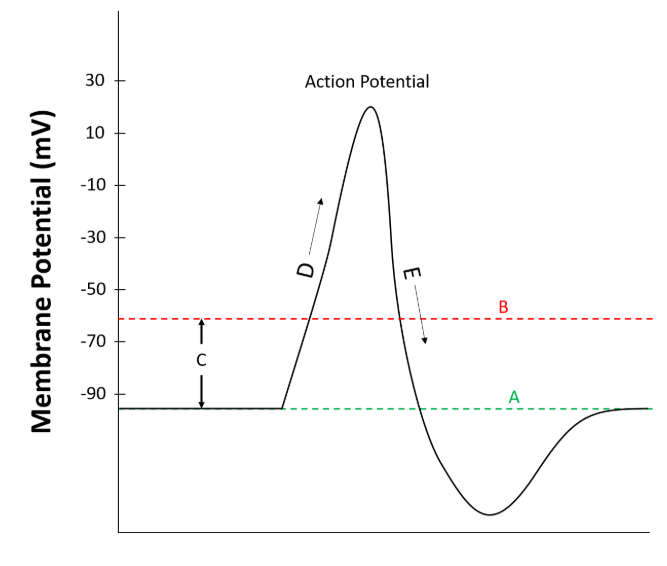
Period of time following an action potential when another action potential cannot be generated
What is the refractory period?
All of the above statements are true
Myelinated nerves
Conduct nerve impulses faster than non- myelinated nerves
Conduct impulses via process known as Saltatory conduction
Have myelin that covers the nerve axon which serves as an insulator to the nerves
All of the above statements are true
acetylcholinesterase blockers
The destruction of nicotinic receptors by the autoimmune disease myasthenia gravis produces muscle weakness due to inadequate impulse transmission at the neuromuscular junction. Which of the following would you think might be useful in diagnosing and treating this condition?
3, 2, 6, 1, 5, 4
Select the correct sequence in the excitation-contraction process in skeletal muscle from the schemes below:
1: cross-bridge formation
2: binding of calcium by troponin
3: propagation of muscle action potential
4: calcium pumped back into SR and relaxation
5: development of tension and muscle shortening
6: tropomyosin pulled off actin active sites